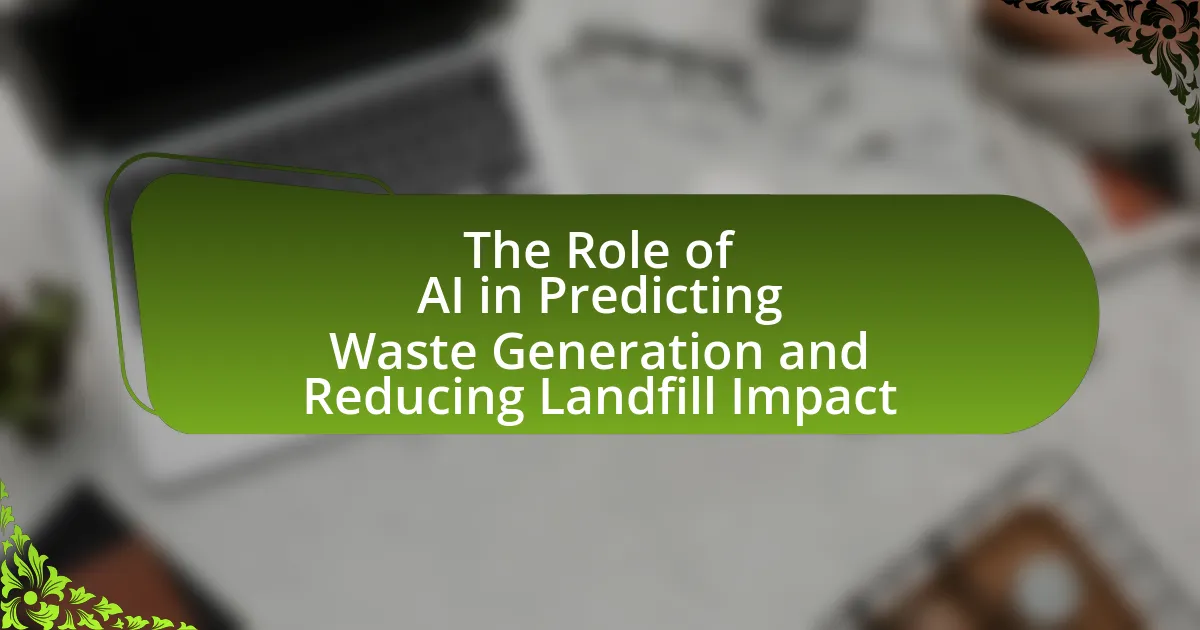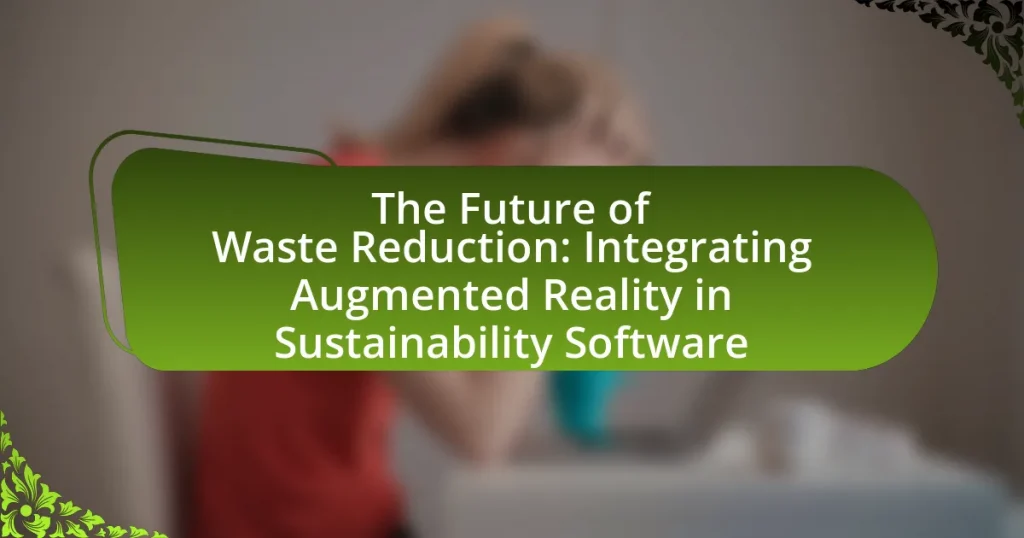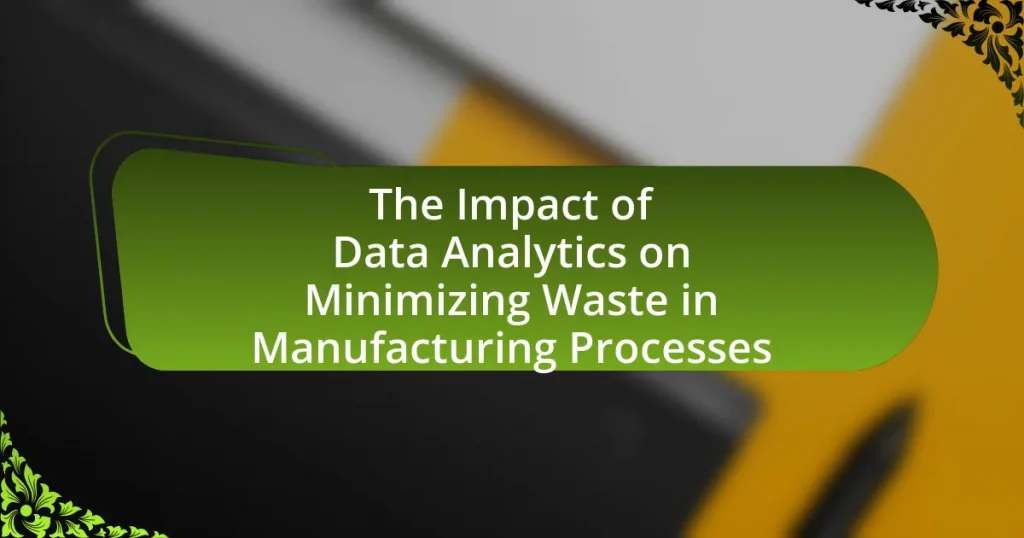The article focuses on the role of artificial intelligence (AI) in predicting waste generation and reducing the impact of landfills. It highlights how AI analyzes large datasets, including historical waste data and real-time sensor information, to accurately forecast waste trends and optimize waste management strategies. Key discussions include the importance of accurate predictions for effective landfill management, the environmental consequences of landfill overflow, and the technologies involved in AI waste prediction systems. The article also addresses the challenges of implementing AI in waste management and outlines best practices for organizations to enhance data quality and collaboration in this field.
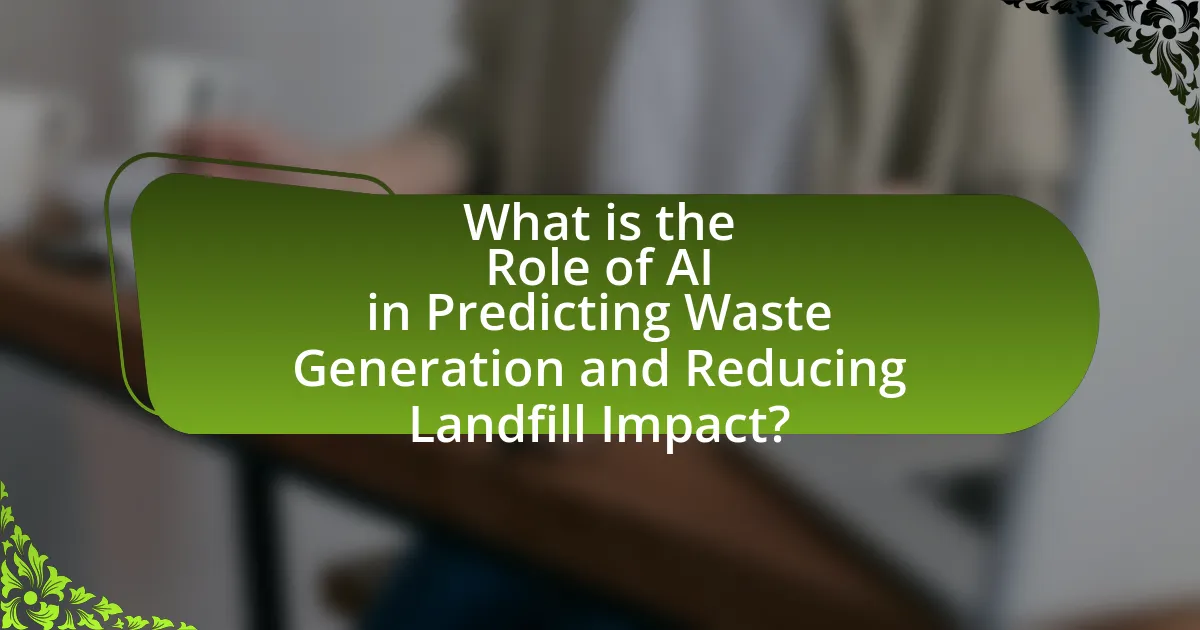
What is the Role of AI in Predicting Waste Generation and Reducing Landfill Impact?
AI plays a crucial role in predicting waste generation and reducing landfill impact by analyzing large datasets to forecast waste trends and optimize waste management strategies. Machine learning algorithms can process historical waste data, demographic information, and consumption patterns to accurately predict future waste volumes, enabling municipalities and organizations to plan more effectively. For instance, a study by the World Economic Forum highlighted that AI-driven models can improve waste collection efficiency by up to 30%, thereby minimizing unnecessary landfill use and associated environmental impacts. Additionally, AI technologies facilitate the identification of recycling opportunities, further decreasing the volume of waste sent to landfills.
How does AI contribute to waste generation predictions?
AI contributes to waste generation predictions by analyzing large datasets to identify patterns and trends in waste production. Machine learning algorithms process historical waste data, demographic information, and economic indicators to forecast future waste generation with high accuracy. For instance, a study by the World Economic Forum in 2020 demonstrated that AI models could predict waste generation rates with up to 90% accuracy by utilizing real-time data from smart bins and urban sensors. This predictive capability enables municipalities and organizations to optimize waste management strategies, allocate resources efficiently, and implement targeted recycling programs, ultimately reducing landfill impact.
What data sources does AI utilize for accurate predictions?
AI utilizes various data sources for accurate predictions, including historical waste generation data, demographic information, environmental factors, and real-time sensor data. Historical waste generation data provides insights into past trends, allowing AI models to identify patterns and make forecasts. Demographic information, such as population density and socioeconomic status, helps AI understand consumption behaviors that influence waste production. Environmental factors, including weather patterns and seasonal variations, affect waste generation rates and are crucial for accurate predictions. Real-time sensor data from smart bins and IoT devices offers immediate insights into waste levels and composition, enhancing the predictive capabilities of AI systems. These diverse data sources collectively enable AI to generate precise forecasts regarding waste generation and inform strategies to reduce landfill impact.
How does machine learning enhance prediction accuracy?
Machine learning enhances prediction accuracy by utilizing algorithms that learn from data patterns and improve over time. These algorithms analyze large datasets to identify correlations and trends that traditional statistical methods may overlook, leading to more precise forecasts. For instance, a study published in the journal “Waste Management” demonstrated that machine learning models could predict waste generation with an accuracy improvement of up to 30% compared to conventional methods. This increased accuracy is crucial in optimizing waste management strategies and reducing landfill impact.
Why is predicting waste generation important for landfill management?
Predicting waste generation is crucial for landfill management because it enables effective planning and resource allocation. Accurate predictions help landfill operators anticipate the volume of waste, which is essential for optimizing space, managing operational costs, and ensuring compliance with environmental regulations. For instance, studies have shown that cities employing predictive analytics can reduce landfill overflow by up to 30%, thereby extending the lifespan of existing landfills and minimizing environmental impact.
What are the environmental impacts of landfill overflow?
Landfill overflow significantly harms the environment by contaminating soil and water sources. When landfills exceed their capacity, waste can leak hazardous materials, such as heavy metals and toxic chemicals, into the surrounding land and groundwater. According to the Environmental Protection Agency, leachate from overflowing landfills can lead to serious health risks for nearby communities and ecosystems. Additionally, overflowing landfills contribute to increased greenhouse gas emissions, particularly methane, which is produced during the decomposition of organic waste. This exacerbates climate change and affects air quality. The cumulative effects of these environmental impacts highlight the urgent need for effective waste management strategies, including the use of AI to predict waste generation and mitigate landfill overflow.
How can accurate predictions lead to better resource allocation?
Accurate predictions enhance resource allocation by enabling organizations to anticipate demand and optimize supply chain processes. For instance, AI-driven models can analyze historical waste generation data to forecast future trends, allowing municipalities to allocate waste management resources more effectively. A study by the World Economic Forum found that predictive analytics can reduce waste collection costs by up to 30% by ensuring that resources are deployed only when and where they are needed. This targeted approach minimizes excess expenditure and maximizes efficiency, ultimately leading to a more sustainable management of resources.
What technologies are involved in AI waste prediction systems?
AI waste prediction systems primarily involve machine learning algorithms, data analytics, and Internet of Things (IoT) technologies. Machine learning algorithms analyze historical waste generation data to identify patterns and predict future waste volumes. Data analytics processes large datasets from various sources, such as municipal records and sensor data, to enhance prediction accuracy. IoT technologies, including smart bins equipped with sensors, collect real-time data on waste levels, enabling dynamic adjustments to waste management strategies. These technologies collectively improve the efficiency of waste management and reduce landfill impact by optimizing collection routes and schedules based on predictive insights.
What role do sensors play in data collection for AI systems?
Sensors are critical in data collection for AI systems as they gather real-time information from the environment, enabling accurate analysis and decision-making. These devices, such as temperature sensors, motion detectors, and cameras, provide essential data that AI algorithms use to identify patterns and trends. For instance, in waste management, sensors can monitor waste levels in bins, allowing AI systems to optimize collection routes and schedules, thereby reducing operational costs and environmental impact. The integration of sensor data with AI enhances predictive capabilities, facilitating proactive measures in waste generation management.
How do predictive analytics algorithms function in waste management?
Predictive analytics algorithms function in waste management by analyzing historical data to forecast future waste generation patterns. These algorithms utilize machine learning techniques to identify trends and correlations in data such as population growth, seasonal variations, and economic factors. For instance, a study by the Environmental Protection Agency found that predictive models can improve waste collection efficiency by up to 30% by optimizing routes based on anticipated waste volumes. This data-driven approach enables waste management companies to allocate resources more effectively, reduce operational costs, and minimize landfill impact.

How does AI help in reducing landfill impact?
AI helps in reducing landfill impact by optimizing waste management processes through predictive analytics and automation. By analyzing historical data and current trends, AI can forecast waste generation patterns, enabling municipalities and organizations to adjust their waste collection and recycling strategies accordingly. For instance, a study by the World Economic Forum found that AI-driven systems can improve recycling rates by up to 30% by accurately sorting materials and identifying recyclable items. This targeted approach minimizes the volume of waste sent to landfills, thereby reducing environmental impact.
What strategies does AI implement to minimize landfill waste?
AI implements several strategies to minimize landfill waste, including predictive analytics, optimization of recycling processes, and smart waste management systems. Predictive analytics utilizes historical data to forecast waste generation patterns, allowing municipalities and businesses to adjust their waste management strategies proactively. For instance, AI algorithms can analyze trends in consumer behavior and seasonal variations to optimize collection schedules, reducing unnecessary pickups and associated emissions.
Additionally, AI enhances recycling processes by identifying materials more accurately through image recognition technologies, which increases the efficiency of sorting facilities. This capability leads to higher recycling rates and less contamination of recyclable materials. Smart waste management systems, powered by AI, utilize sensors and IoT devices to monitor waste levels in real-time, enabling more efficient routing of collection vehicles and reducing the overall volume of waste sent to landfills.
These strategies collectively contribute to a significant reduction in landfill waste, as evidenced by studies showing that cities employing AI-driven waste management systems can reduce waste by up to 30%.
How can AI optimize recycling processes?
AI can optimize recycling processes by enhancing sorting accuracy and improving operational efficiency. Machine learning algorithms analyze waste materials, enabling automated systems to identify and separate recyclables from non-recyclables with up to 95% accuracy, as demonstrated by companies like AMP Robotics. Additionally, AI-driven predictive analytics can forecast waste generation patterns, allowing recycling facilities to adjust operations proactively, thereby reducing contamination rates and increasing the volume of materials processed. This optimization leads to higher recycling rates and lower landfill contributions, supporting sustainability goals.
What role does AI play in waste sorting technologies?
AI plays a crucial role in waste sorting technologies by enhancing the accuracy and efficiency of material identification and separation processes. Through advanced machine learning algorithms and computer vision, AI systems can analyze waste streams in real-time, distinguishing between different types of materials such as plastics, metals, and organics. For instance, a study by the Massachusetts Institute of Technology demonstrated that AI-powered sorting systems achieved over 90% accuracy in identifying recyclable materials, significantly improving recycling rates and reducing contamination. This technological advancement not only streamlines waste management operations but also contributes to environmental sustainability by promoting effective recycling and minimizing landfill usage.
Why is it crucial to reduce landfill impact?
Reducing landfill impact is crucial because it minimizes environmental degradation and conserves natural resources. Landfills contribute to soil and water contamination, release greenhouse gases like methane, and occupy valuable land space. According to the Environmental Protection Agency, landfills are the third-largest source of methane emissions in the United States, accounting for approximately 15% of total emissions. By reducing landfill impact, we can enhance public health, promote sustainability, and mitigate climate change effects.
What are the long-term consequences of landfill waste accumulation?
The long-term consequences of landfill waste accumulation include environmental degradation, groundwater contamination, and increased greenhouse gas emissions. Over time, decomposing waste releases toxic substances that can leach into soil and water sources, posing risks to human health and ecosystems. For instance, a study by the Environmental Protection Agency indicates that landfills are a significant source of methane, a potent greenhouse gas, contributing to climate change. Additionally, the accumulation of waste can lead to habitat destruction and loss of biodiversity as natural areas are converted into landfill sites.
How does reducing landfill impact benefit communities?
Reducing landfill impact benefits communities by decreasing environmental pollution and enhancing public health. When landfills are minimized, harmful emissions such as methane and leachate are significantly reduced, leading to cleaner air and water sources. For instance, a study by the Environmental Protection Agency indicates that reducing landfill waste can lower greenhouse gas emissions by up to 50%, which directly contributes to improved community health outcomes. Additionally, communities can experience economic benefits through increased recycling and composting initiatives, which create jobs and promote sustainable practices.
What are the challenges faced in implementing AI for waste management?
The challenges faced in implementing AI for waste management include data quality issues, integration with existing systems, and the need for skilled personnel. Data quality is critical, as inaccurate or incomplete data can lead to ineffective AI models; for instance, a study by the World Economic Forum highlights that poor data can result in a 30% decrease in AI effectiveness. Integration challenges arise because many waste management systems are outdated, making it difficult to incorporate advanced AI technologies. Additionally, there is a shortage of skilled personnel who can develop and maintain AI systems, which is evidenced by a report from McKinsey stating that 70% of organizations struggle to find qualified AI talent. These factors collectively hinder the successful implementation of AI in waste management.
What barriers exist in data collection and integration?
Barriers in data collection and integration include data silos, inconsistent data formats, and privacy concerns. Data silos occur when information is isolated within departments or systems, hindering comprehensive analysis. Inconsistent data formats complicate the merging of datasets, leading to errors and inefficiencies. Privacy concerns arise from regulations like GDPR, which restrict data sharing and collection practices, limiting the availability of necessary data for effective integration. These barriers collectively impede the ability to leverage AI for predicting waste generation and reducing landfill impact.
How can organizations overcome resistance to AI adoption?
Organizations can overcome resistance to AI adoption by fostering a culture of openness and education regarding AI technologies. This involves providing training programs that enhance employees’ understanding of AI’s benefits and applications, which can alleviate fears and misconceptions. Research indicates that organizations that invest in employee education about AI see a 30% increase in acceptance rates, as employees feel more equipped to engage with new technologies. Additionally, involving employees in the AI implementation process can create a sense of ownership and reduce resistance, as they can contribute their insights and feedback.
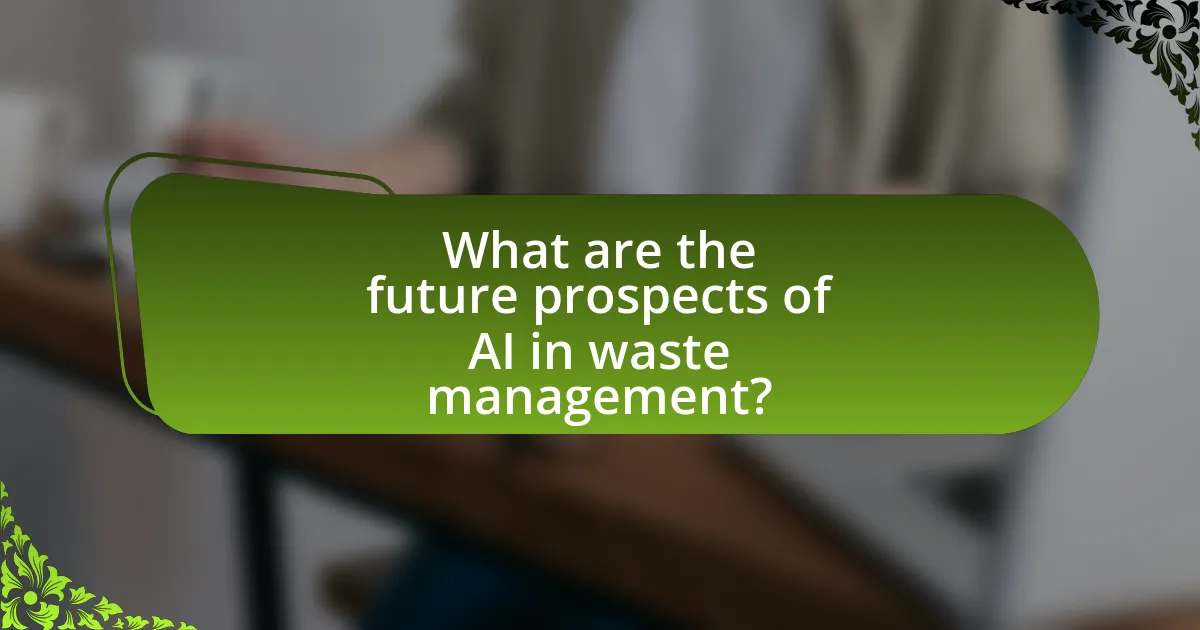
What are the future prospects of AI in waste management?
The future prospects of AI in waste management are highly promising, with advancements expected to enhance efficiency in waste sorting, recycling, and resource recovery. AI technologies, such as machine learning and computer vision, can significantly improve the accuracy of waste classification, leading to higher recycling rates and reduced contamination. For instance, a study by the World Economic Forum indicates that AI can increase recycling rates by up to 30% through better sorting mechanisms. Additionally, predictive analytics powered by AI can optimize waste collection routes, reducing operational costs and carbon emissions. As cities increasingly adopt smart waste management systems, the integration of AI will likely play a crucial role in achieving sustainability goals and minimizing landfill impact.
How is AI expected to evolve in waste generation prediction?
AI is expected to evolve in waste generation prediction by integrating advanced machine learning algorithms and real-time data analytics to enhance accuracy and efficiency. This evolution will involve the use of big data from various sources, such as IoT sensors, social media trends, and demographic information, allowing for more precise forecasting of waste generation patterns. For instance, a study by the World Economic Forum highlights that AI can analyze historical waste data alongside current consumption trends to predict future waste volumes with up to 90% accuracy. This capability will enable municipalities and organizations to optimize waste management strategies, reduce landfill impact, and improve recycling rates.
What advancements in technology could enhance AI capabilities?
Advancements in quantum computing could significantly enhance AI capabilities by enabling faster processing of complex algorithms. Quantum computers utilize qubits, which can represent multiple states simultaneously, allowing for exponential increases in computational power compared to classical computers. This increased power can improve machine learning models, enabling them to analyze vast datasets more efficiently and accurately. For instance, research from IBM has demonstrated that quantum algorithms can solve optimization problems much quicker than traditional methods, which is crucial for AI applications in waste management and landfill impact reduction.
How might regulations influence AI development in waste management?
Regulations can significantly influence AI development in waste management by establishing standards that ensure compliance with environmental goals. For instance, regulations may require AI systems to optimize waste sorting processes, thereby enhancing recycling rates and reducing landfill use. The European Union’s Waste Framework Directive mandates member states to achieve specific recycling targets, which drives the adoption of AI technologies that can efficiently analyze and predict waste generation patterns. This regulatory pressure encourages innovation in AI solutions that align with sustainability objectives, ultimately shaping the direction of research and development in the field.
What best practices should organizations follow when implementing AI in waste management?
Organizations should follow best practices such as conducting thorough data analysis, ensuring stakeholder engagement, and implementing continuous monitoring when implementing AI in waste management. Thorough data analysis is crucial as it helps organizations understand waste patterns and optimize collection routes, leading to a 20-30% reduction in operational costs, as reported by the World Economic Forum. Engaging stakeholders, including local communities and waste management personnel, fosters collaboration and ensures that AI solutions meet real-world needs. Continuous monitoring allows organizations to adapt AI systems based on performance metrics and changing waste generation trends, enhancing the effectiveness of AI applications.
How can organizations ensure data quality for AI systems?
Organizations can ensure data quality for AI systems by implementing rigorous data governance frameworks that include data validation, cleansing, and continuous monitoring. These frameworks establish clear protocols for data collection, ensuring that data is accurate, consistent, and relevant to the AI models being developed. For instance, a study by the Data Management Association highlights that organizations with strong data governance practices experience a 30% reduction in data errors, which directly enhances the performance of AI systems. Additionally, employing automated tools for data quality assessment can help identify anomalies and inconsistencies in real-time, further supporting the integrity of the data used in AI applications related to waste generation and landfill impact.
What collaborative efforts can enhance AI’s effectiveness in waste management?
Collaborative efforts that can enhance AI’s effectiveness in waste management include partnerships between technology companies, local governments, and waste management organizations. These collaborations enable the sharing of data, resources, and expertise, which are crucial for developing AI algorithms that accurately predict waste generation patterns. For instance, a study by the World Economic Forum highlights that integrating AI with real-time data from municipal waste collection systems can improve operational efficiency by up to 30%. Additionally, joint initiatives for public awareness campaigns can foster community engagement, leading to better recycling practices and reduced waste generation. Such collaborative frameworks not only optimize AI applications but also contribute to sustainable waste management practices.
